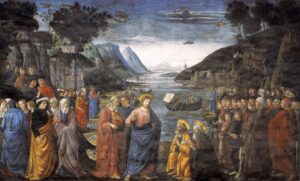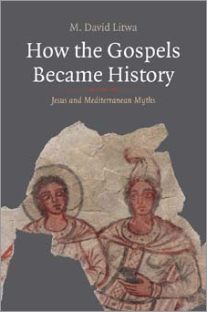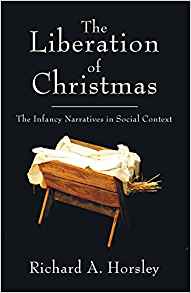Critique of the Gospel History of the Synoptics
by Bruno Bauer
Volume 1
—o0o—
106
§ 9.
The flight to Egypt and settlement in Nazareth.
In his presentation of the prehistory, Luke incorporated the prophecy of the struggles which the Redeemer and, in him, the new principle would have to endure. Through the soul of Mary, who represents the community in a broader sense here, Simeon says a sword will pierce through her, for this one who was destined to be the light of the Gentiles and the glory of Israel, is set for a sign, which is opposed so that many hearts may be revealed.
Matthew also takes up this prophecy and, like the other one about the destiny of the Savior to be the light of the nations, works it into a prophetic fact with the same success that gives him a result he had not even calculated, in which the destinies of the community and its Lord are symbolically prefigured.
107
The collision develops from the wondrous event that the Gentiles offer their homage to the Messiah. In its essential sense, it must therefore be of general and comprehensive significance, even if the author uses Jewish names for the narrative. He could not do otherwise, as he is writing the story of the child born in Bethlehem, and could only depict dangers that were possible in the Jewish world of that time. His consciousness in which he created this story was involuntarily limited by this necessary limitation of the scene, and with good faith in the direction that his narrative takes from its starting point, he believes that he is describing real dangers that were imposed on the newborn by the Jewish world and its ruler of the time. On the other hand, his consciousness is involuntarily beyond these limitations again, as he portrays the struggles of the messianic child, which the community only experienced and experienced with such terrible seriousness when it was in conflict with the Gentile world and its rulers. In the child, the idea of the community, which passed through dangers and sufferings unscathed, is depicted, while the children of Bethlehem represent the individual sacrifices that fall when the idea itself triumphs over the attacks of the world. The Magi are the harbingers of Gentile-ism that submits to the new principle, while Herod represents in his person the secular power that could not reach the principle, the idea with its weapons, in its struggle with Christianity, although it could hit individual members of the community. Of course, the author did not separate both sides of his narrative, the Jewish scene and form and the general content, to which the community and its destiny in the struggle with the world empire also belonged, and did not make the messianic child as such and the community whose destiny it experienced into one being with reflective intentionality, and it was therefore inevitable that some inconveniences arose from the combination of such diverse elements. However, the fact that the collision and its development still combine into such a harmonious whole can be explained particularly by the fact that it begins with the homage of the Gentiles and that in Herod, whose person and house were regarded by the evangelist more as a foreign, external, and worldly power than as an element of the theocratic sphere of life, the hostile power of the world is juxtaposed as a counter-image.
108
Before we examine the account of the danger threatening the infant Jesus in detail, as far as it is necessary here, we hardly need to mention that in an apologetic sense there can no longer be any talk of a historical basis for it, if the assumption of the Magi’s arrival does not belong to real history. The fact that the characters in the story are under the immediate guidance of a necessity that either determines their decisions, as with the Magi and Joseph in their dreams, or leads Herod to both premature and inconsistent actions, as required by the development of the collision, but which are impossible in reality, also proves this ideal origin of the account.
When Herod learned from the scribes that the Messiah would be born in Bethlehem, he secretly summoned the Magi and asked them precisely about the time when the star had appeared. But why secretly? Why so precise? Why did he ask about a sign from which he could deduce the age of the child, since he instructed the Magi to bring him news if they found the child and he firmly believed that they would return to him? The age of the child could only be of interest to Herod when, deceived by the Magi, who, warned by a dream, did not return to him, he decided to kill all the children in Bethlehem and the surrounding area “who were two years old or younger.” He could only resort to this means when he could no longer learn from the Magi which child was so dangerous to him; and yet he had already asked about the more distant means, namely the sign, from which he could deduce up to what age he had to have the children killed (Matthew 2:16). If, at the arrival of the Magi, he had thought of such a remote means for carrying out his purpose, and thus of the possibility that they might deceive him and not return to him, he would have reached for the nearer means and assigned secret escorts to the foreigners who would have more safely and less conspicuously removed the dangerous child from their path. The answer of modern apologists, that tyrants are often struck with stupidity in their vague fear, as audacious as it may be, can only make an impression as long as one has only superficially and from afar considered Saint Matthew’s account. Just listen to the account, how clearly it emphasizes that Herod had already thought of the last desperate means with his question about the rising of the star. This Herod would have been struck with stupidity? Calvin knew the difficulty better, if he could find no other way to solve it than by assuming that God had made the tyrant helpless for a moment. *) You want to solve the difficulty if Calvin could not, even though he allowed God himself to participate? In fact, it cannot be solved apologetically, for he who knows how to get advice even for the remotest possibility cannot be said to be helpless. And if God really deprived the tyrant of his reason to such an extent that he did not think of giving the Magi escorts, would he not have had to go so far as to prevent him from coming up with the clever idea of asking about the rising of the star?
*) Non dubium est, quin Deus mentem ejus perculerit inusitato metu, ut consilio destitutus menteque alienatus ad tempus torperet. Nihil enim facilius erat, quam officii praetextu unum ex aulicis comitem subordare, qui tota inspecta mox rediret.
110
The matter is immediately resolved once we consider the only force that has been at work here, the pragmatism of the writer. Actually, Herod should not even have asked so cunningly about the time when the star appeared, because he believed he was sure to be informed by the Magi about the child on their return journey through Jerusalem. However, the writer knows beforehand that they will be warned in a dream and take another way back, and based on the insight he has, which he only reveals secretly to Herod, he lets him act and use the only opportunity when he speaks to the Magi to find out when the star appeared. But he had to have Herod ask about it because he already had in mind the bloodshed in Bethlehem and had to send the tyrant the information he needed to deduce at what age he should get rid of the children if he wanted to eliminate the one dreadful child among them.
It is striking that the Evangelist does not allow the Magi to return to Herod. There was no more danger to fear, because immediately after their departure, Joseph received a command in a dream to flee with the child and his mother to Egypt. The fate of the children of Bethlehem would have remained the same. Nevertheless, a correct instinct prevented the Evangelist from sending the Magi back to Herod with the news of where they had found the Savior. In general, Weisse correctly indicated the idea that guided the Evangelist secretly, when he said *) that “the same religious consciousness of the heathen world, which, guided by the spirit of truth, submits to Christianity, is abandoned by that spirit to the secular power that has risen from the heathen world, an involuntary impulse to persecute Christianity.” But the matter can be more precisely formulated as follows: in its enmity towards the community, the secular power does not know where to strike the principle and life of the community, and while the idea is impervious to its attacks, in blind fury, it can only reach individuals who suffer for the principle with its weapons.
*): ev. Gesch. I, 224.
111
The murdered children of Bethlehem are considered by our evangelist as martyrs or, to express our own understanding more precisely, as prototypes of martyrs, and he ensured that they did not perish without being mourned. He says that their suffering fulfills the prophecy of Jeremiah (31:15), which speaks of Rachel weeping bitterly for her children and refusing to be comforted. Certainly, we would completely misunderstand the evangelist’s perspective if we were to assume that the prophetic passage refers only to the anguish of mothers whose children were taken by Herod. These children are no longer just those who belong to this or that household in Bethlehem, but are martyrs of the suffering community, or rather the part of the community that was sacrificed. Now it is clear who Rachel is. She is the community that weeps over the suffering of her members. This is also the original meaning of those words in the scripture of Jeremiah: they refer to the deportation of the people into captivity. Rachel, the matriarch, stands at Rama, in the territory of her son Benjamin, where the procession of captives must pass by, mourning the misfortune of her kin. For the evangelist, the fact that Rachel was buried near Bethlehem leads him to the prophet’s statement, and Rachel’s grief is now the mourning of the community that has lost its children in the children of Bethlehem. It does not surprise us that the evangelist makes the community lament, even though the community did not yet exist at the time, since he also makes martyrs suffer when it was not yet possible.
112
The view of the evangelist becomes even more clear to us when we remember that we speak of a community in three senses. Firstly, as it appears in individual members, secondly as it is the substantive unity, figuratively speaking, the mother of these individuals, and finally, as it summarizes itself in its personal principle. All three meanings must have also been present in the early Christian view, as soon as it attempted to present itself in the form of history, to be made into independent figures, and from this, the diversity and richness of figures arose, even in the limited framework of this prehistory. At the point especially where the idea of suffering emerges, we can expect this threefold representation and representation of the community, and Luke has even carried it out in a surprising way in the fleeting moment where suffering is only mentioned. We say again, not with conscious intent, but instinctively following the power of that differentiation; just as we don’t always pay attention when we speak of the community, that we are speaking of it in this or that sense. When Simeon says, “This child is destined to cause the falling and rising of many in Israel,” he does not only mean that Jesus would suffer in his personal historical appearance, but he also thinks of the struggles and sufferings that the community will have to endure. Mary, through whose soul a sword will go, is not only the sorrowful mother of the Savior, who would witness his suffering and crucifixion, but she also represents the community in that sense, in which she is the substance of the individual members and seems to look down sympathetically on the struggles of her own in maternal empathy.
Matthew has only separated and shaped this more clearly because he set the individual historical events in motion. The worldly power wants to carry out its hostile plans, but it cannot find the personal principle, it can only reach the individual, inherently weak members of the community and, by the death of these, hurt the community, which maintains itself as a substantive unity above the struggle of appearance, for a moment.
113
The flight of Joseph with the child to Egypt seems significant to the Evangelist, and he sees in it the fulfillment of the prophetic word in Hosea 11:1, where Jehovah speaks of his son whom he called out of Egypt. Although this passage speaks of the past, of the liberation of the people from Egypt and only of the people as such, the Evangelist focuses his attention only on the fact that Jehovah speaks of his son, and therefore concludes that this son can only be Jesus.
After the death of Herod, Joseph receives instruction from an angel in a dream to return to the land of Israel. He obeys but fears when he hears that Archelaus reigns over Judea, and in another dream, he is instructed to go to Galilee, where he settles in Nazareth. The Evangelist says that this happened so that the word of the prophets, “he shall be called a Nazarene,” would be fulfilled. In Jesus growing up in Nazareth and leaving from there when he began his public ministry, he sees a sign of the lowliness of the Messiah in his historical appearance. He recalls that Isaiah (11:1) compares the Messiah, who comes from humble circumstances, to a weak branch that grows from the stump of a cut-down tree. He sees this as a literal reference to the Messiah’s emergence from a small town in a remote province away from the capital, and he speaks in the plural of the prophecy of the prophets because he finds the idea of the Messiah’s lowly appearance in other prophecies besides those of Isaiah.
The latter reflection of the Evangelist clearly proves that he also has in mind and wants to depict the struggle and contradiction between the higher destiny of the messianic child and the fate that drives him into obscurity during these wanderings. The material for this portrayal was initially given to him to the extent that it was established according to the report of Mark that Nazareth was considered to be the hometown of Jesus and that the Lord came from this remote and otherwise unknown city when he began his public ministry (Mark 6:1, 1:9). Additionally, there is the note of the third synoptist that the holy family returned with the child to Nazareth from the scene of those wonders which had glorified the birth and first days of the messianic child (Luke 2:39). Luke lets this return journey go as quickly as possible – immediately after the mother of the child had followed the legal requirements (Luke 2:22-24) – and does so without any concern: he still feels the power of the positive statements in the Gospel of Mark and now has to hurry to bring the child back to where he is at home according to his informant. However, Matthew is already accustomed to considering Bethlehem as the birthplace of the Messiah, so it is possible for him, if he wants to report on the birth of the Lord, to simply assume this city as the location. With his reflective style, it is not surprising that he emphasizes the contrast between the cradle of kings and a corner of Galilee, but he will also seek to convey and understand it as a divine fate. It is now the jealousy and enmity of worldly power that drives the royal child away from the homeland of his ancestors, forever away from it, and finally forces him to grow up in the obscurity of Nazareth. Matthew had based his entire presentation on this struggle, so the wanderings of the persecuted child are the natural consequences of this unfortunate collision, but the consequences that are foreseen by God, prophesied by the prophets, and under the guidance of a higher necessity.
115
Why, however, does Joseph not receive the instruction to go to Galilee and settle in Nazareth immediately at the beginning, when Herod seeks the child’s life in Bethlehem? It was not yet possible at that time, because Herod also ruled over that province and could still track down the child. So, abroad, into foreign lands, until the danger is over! But to which country? To the nearest one, to Egypt, where the people whose fortunes parallel those of the Messiah have also lived in hiding until they could take possession of their inheritance, which God had destined for them.
The richness of the form of thought we are dealing with here often gives the appearance of excess when the idea, already expressed in one event, is expressed anew in an analogous event. After the death of the tyrant, the child does not yet find peace. Although Joseph hears from the angel that those who were seeking the child’s life are no more and leaves Egypt to settle in Judaea, the homeland of the messianic child, a new danger threatens, and the child must bid farewell to its cradle forever and seek a new home in a foreign land.
However, we must not regard such repetitions as mere superfluity. The sunny view is involuntarily driven to such duplications in order to increase the seriousness of the collision or to allow it to emerge fully in its fateful power. Usually – and this is what happened here – the repetition takes the form of compressing the collision and its development into a narrower space by the fact that the demonic spirit of persecution still works over the grave of the departed enemy.
These wanderings and sufferings of the messianic child only acquire their true meaning when we do not forget that the child’s fate itself represents the arrangements that gave the church the recognition of the Gentiles and protected it through suffering and persecution. It is the same here. Herod remains the representative of worldly power, from which the church is forced to found and expand its kingdom in quiet and seclusion.*) This general idea will be more specifically developed the second time the pressure of worldly power is renewed, and when the church is displaced from the seat and center of worldly glory, the opposite point to which it flees will be of greater significance. The child that represents the church is led from Judaea to Nazareth, and its fate of being relegated to the lowly corners of a little-regarded province is now the image of the church’s fate, which, despised by worldly glory, gathered its followers among the lowly and humble. **)
*) Compare Weisse, ev. Gesch. I, 226.
**) For the followers of Christ were already called Nazarenes very early, before the time when Matthew wrote (ναζωραιοι Acts 24:5).
116
Even more so! Nazareth, Galilee, the circle of the Gentiles, as it was called by the Jews, and Judah now stand opposed to each other. The hostile power that threatens the child and, in it, the community and drives it away into the distance, is no longer just the secular power, but now acts as the old Jewish essence, which fears its downfall and, in order to save itself, expels the new principle from its homeland and forces it to settle in the Gentile world.
One would think that the apologist would never again think to connect the Gospel accounts of Luke and Matthew in an external context, if it is shown to him how both arose. Their true connection is solely grounded in the fact that the seeds of the later account were already contained in the former and developed into the shape of the later view through their inner power, which certainly also had to be expressed through richer experiences.
117
If by chance the other connection were present, that both stories fit together with their individual dates, it would be only by chance and would be absolutely indifferent to us, since both circles of thought each form a particular world, and the later one, even if it takes its central idea from the earlier one, gives its movement a direction that takes no account of the rotation of the first circle. There is not even an accidental external connection possible: on the contrary, the most extraordinary differences must occur, which, however, will not disturb or even occupy us any more than the mechanical harmony, if it were possible, would be of importance to us.
Nevertheless, we will hardly be able to entertain the excessive hope that the apologist will refrain from harmonizing the two stories, because they are and remain real history to him. They must remain so to him because he would be despondent if he did not see in them not only individual, in themselves random events, but a thoughtful creation of the religious spirit. We will therefore do him the last favor and relieve him of the burden of his harmonistic work by showing him how the external contradictions of the two stories arose.
Luke has Joseph and Mary return to Nazareth immediately after they had fulfilled everything that the law required of a woman after childbirth, that is, forty days after the birth of the child. Immediately! He not only does not know of the detour through Egypt, which must have already taken a lot of time, and the longer stay of the child in this country until the death of Herod, but he excludes this delay. In this case, he would proceed so exclusively if one wanted to force a historical cycle into his report with harmonistic tenacity, which only his successor has developed. But why did Matthew not heed the barrier that Luke actually set for the later historian with his chronological note about the return of the holy family to Nazareth? Because he did not surround the birth of Jesus from all sides with a multitude of miraculous events like his predecessor, and therefore could not conclude the prehistory so early; because the one incident he cites, the arrival of the Magi, was the cause of a series of collisions whose far-reaching development had to give way to that barrier; and finally, because in this time of creative thought, a chronological note was not yet as rigid as it has become for the sober apologist. But let us speak more cautiously! Only sometimes or depending on his interest, the apologist remains stubbornly on a single note. This time he has precisely the interest of adding the surplus he finds in Matthew to Luke’s narrative. But if he suddenly exceeds or pushes beyond the barrier of that chronological note, why should it not be possible or allowed for Matthew, since his view was just driven by the first force of an interest, whose development required a larger scope?
118
It is actually unnecessary to ask where to insert the homage of the Magi in Luke’s narrative. Luke knows nothing of these foreigners because he is unaware of the unfortunate consequences of their arrival; he does not need them, as in his version, the shepherds and Simeon give homage to the child, which the Magi give according to Matthew’s account. Finally, he excludes any thought of these foreigners, for if the Magi had arrived before the presentation of the child in the temple and a divine messenger had commanded Joseph to flee to Egypt, could the parents have brought the threatened child so freely and openly to Jerusalem? After the presentation in the temple, the parents bring the child – and again, to emphasize, without delay – to their home in Galilee, to Nazareth. Therefore, the Magi could not have given homage to the child in Bethlehem afterward. These are difficulties that the apologist will never be able to overcome, but they do not exist for Matthew, as the homages given to the messianic child by Luke are summarized by him into one homage by the Magi, thus placing them ideally, and making it impossible for him to raise any chronological concerns. Luke has made the recognitions given to the messianic child follow each other step by step, culminating in the praise of Simeon, so that there is no room for another, new homage in his narrative. Matthew, on the other hand, has given the homage of the Magi such far-reaching significance that his account does not need any other.
119
We have already shown how the differences between the two accounts of the origins of Jesus’ parents’ residence came about. According to Luke, Jesus’ parents were settled in Nazareth, and the census, a random occurrence, leads Joseph and the pregnant Mary to Bethlehem, where Jesus is born. The fact that the census was announced at that specific time, and that Mary had to stay in Bethlehem for the birth, is not considered by the evangelist to be coincidental; rather, he sees in this arrangement the influence of a higher necessity, which wanted the Messiah, as the Son of David, to be born in the cradle of his lineage. However, Matthew presents this necessity as an immediate divine will, by weaving the well-known prophecy of Micah into his account. He no longer needs the historical circumstance of the census, and so naturally, Jesus’ parents are from Bethlehem from the beginning. This also allows him to portray the return to Nazareth, which, according to Luke, was just a return home, not as something that is self-explanatory, but rather as a significant achievement that could only be brought about by a series of historical events and the necessity of fulfilling a divine oracle.
120
Will the apologist perhaps say again that the contradiction is only apparent and that this appearance arises because Matthew considers the matter only from a different point of view and in connection with the prophecies of the Old Testament? This would only be an illusion if Matthew portrays Joseph’s intention to settle in Judea, namely in Bethlehem, after his return from Egypt, as so serious that Joseph still entertains it even when he sees that the new ruler in Judea is no less to be feared than Herod, that Joseph is without advice in this embarrassment and does not even remotely consider staying in Galilee, in Nazareth, where Archelaus has no power, his homeland and a safe refuge, in short – that Joseph is only directed to Galilee and Nazareth through an angelic message? The contradiction is as harsh as it can be.
He who wants to save everything in danger may lose everything.
But will the apologist perhaps bring something or much to safety if he shows some resignation and, like Neander, pretends not to consider everything in the reports as sound and healthy? No! The apologist cannot give up anything from the letter, he only says *) “gaps” must be in the reports and these gaps must now pay for all contradictions! Everything, everything, even if separated by gaps, should remain! However, whoever calls reports that are true works of art in their own way “gappy” should at least indicate these gaps in themselves and in their internal construction.
*) L.J. Chr. p. 33
We have done our duty by showing how each of the two accounts is a complete whole in itself, in which each, even the smallest, element is connected with the other in internal connections, and all together with the spirit that animates them form a creation that requires no completion and rejects the most benevolent offer to supplement it as superfluous and at least intrusive. Finally, if Neander thinks that the contradiction of these narratives disappears when one considers them “as such, which were distinguished and collected independently of one another,” *) we have already made the attempt to consider them as such impossible in advance, as we have shown how the gospel prehistory of Matthew arose from that of Luke and how mother and daughter had to have very different features despite all similarities and equal beauty.
*) L. J. Ch. p. 33.
121
The result is: the prehistory of Matthew has its seeds in that of Luke and has been developed from these seeds into its distinctive form. There may still be objections, but we will answer them.
——————————————————————-
Like this:
Like Loading...







